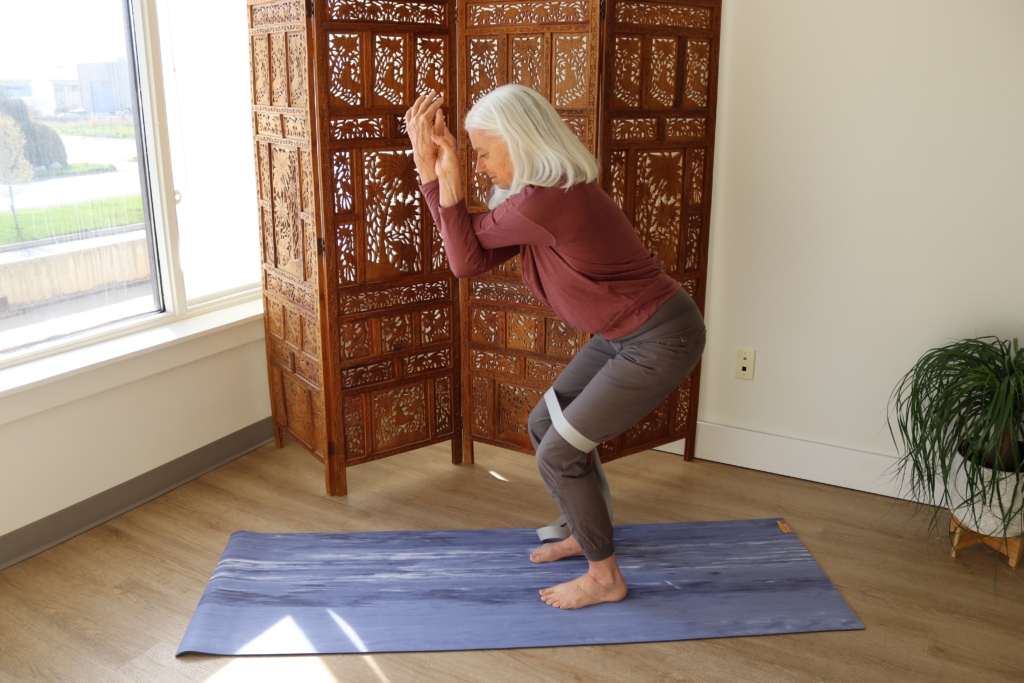This entry was posted on Jul 2, 2024 by Charlotte Bell.

When I first began practicing yoga, I felt like a star. While I was a pretty fair sprinter and long jumper in high school, my body was simply too floppy for other sports. In yoga, my body was pretty immediately able to do all the “fancy,” flexibility-related poses—a real ego boost. For many years yoga practice geared toward increasing my flexibility was my North Star. Since then, I’ve realized that yoga for hypermobility is really about balancing all that bendiness with stability.
I avoided practicing strengthening poses for decades. They were just too hard. Part of the issue was structural. Hypermobile people’s joints don’t always correctly align. This makes the muscles have to work harder to keep us upright. This is complicated further by the fact that hypermobile people don’t always recruit the proper muscles in order to accomplish particular movements in the most efficient way.
Yoga for Hypermobility: Recruiting the Right Muscles
In her recent book, Yoga for Bendy People, author Libby Hinsley calls bendy people “expert compensators.” She writes, ”One of the superpowers of bendy people is they are expert compensators, meaning they can make movements happen using dysfunctional patterns of muscle recruitment and contraction.”
What this means is that hypermobile people often have trouble locating the correct muscles to accomplish a task. As a result, we tend to develop compensatory habits. Hinsley uses the example of Bridge Pose (Setu Bandha Sarvangasana).
For many years, I would suffer hamstring cramps when I practiced Bridge. This is because my glutes, which are the primary hip extenders, weren’t doing their job. Instead, the hamstrings were my primary movers in the pose. While the hamstrings can support the glutes in the pose, taking on the primary responsibility for hip extension is not their forte. Overworking them caused the cramping.
Movement Dysfunction in Fierce Pose
Fierce Pose (Utkatasana aka “Chair Pose”) was another pose I powered through for years, not using my primary support muscles—gluteus maximus and medius. It’s not that my leg muscles weren’t participating; they were on fire. But despite all the effort I was investing in the pose, it still felt somewhat unstable.
In her book on yoga for hypermobility, Hinsley recounts struggles with Chair Pose as well. Suffering with chronic sacroiliac (SI) joint issues and back pain, she worked hard to strengthen her legs. It wasn’t until she began using a Yoga Strap in Utkatasana that she began to be able to practice the pose with much more ease. Pressing out against a Yoga Strap in the pose invites the glutes to the party, making the pose feel so much more stable and easeful. I’ve found it to be a tremendous help in my own practice.
How to Practice Fierce Pose with a Yoga Strap
- Gather your props: a Yoga Mat and a Yoga Strap.
- Make a loop in your Yoga Strap.
- Stand in Mountain Pose (Tadasana) with your feet hips-width apart. Place the strap around your legs just above your knees. Adjust the width of your loop so that when you press your legs into it your feet remain hips-width apart.
- Place your hands on your pelvic rim, or place your arms in Garudasana (Eagle Arms), as in the photo. The arm position isn’t super important, because we’re focusing on the glutes and legs here, so do whatever is most comfortable.
- Tilt your pelvis forward, sending your tailbone back so that your knees begin to bend. Continue this movement until your knees are in a 90- to 120-degree angle.
- Plant your heels. There’s a tendency to shift weight forward into the balls of the feet in Utkatasana. Rooting your heels can help stabilize the pose.
- Now press your legs strongly outward into the Yoga Strap. Then tune into your glutes, including your outer glutes. How does your pose feel overall? Does it feel more or less stable?
- Stay for 5 to 10 deep breaths, then return to Tadasana.
- Repeat if you like.
About Charlotte Bell
Charlotte Bell discovered yoga in 1982 and began teaching in 1986. Charlotte is the author of Mindful Yoga, Mindful Life: A Guide for Everyday Practice and Yoga for Meditators, both published by Rodmell Press. Her third book is titled Hip-Healthy Asana: The Yoga Practitioner’s Guide to Protecting the Hips and Avoiding SI Joint Pain (Shambhala Publications). She writes a monthly column for CATALYST Magazine and serves as editor for Yoga U Online. Charlotte is a founding board member for GreenTREE Yoga, a non-profit that brings yoga to underserved populations. A lifelong musician, Charlotte plays oboe and English horn in the Salt Lake Symphony and folk sextet Red Rock Rondo, whose DVD won two Emmy awards in 2010.

